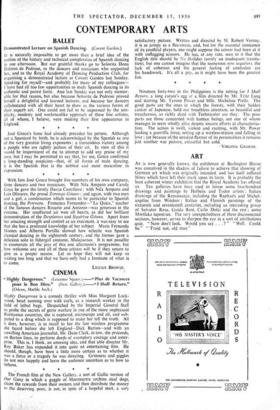CONTEMPORARY ARTS
BALLET
Demonstrated Lecture on Spanish Dancing. (Covent Garden.)
Is is naturally impossible . to get more than a brief idea of the outline of the history and technical complexities of Spanish dancing in one afternoon. But our grateful thanks go to Senorita Dona Dolores de Pedroso, to the dancers and musicians who supported her, and to the Royal Academy of Dancing Production Club, for organising a demonstrated lecture at Covent Garden last Sunday. Speaking for myself—and probably for many of my colleagues— I have had all too few opportunities to study Spanish dancing in its authentic and purest form. And last Sunday was not only memor- able for that reason, but also because Senorita de Pedroso proved herself a delightful and learned lecturer, and because her dancers collaborated with all their heart to show us the various forms of their superb art. One could not fail to be impressed by the sim- plicity, modesty and workmanlike approach of these fine artistes, all of whom, I believe, were making their .first appearance in England.
Jose Greco's fame had already preceded his person. Although not a, Spaniard by birth, he is acknowledged by the Spanish as one of the very greatest living exponents: a tremendous victory among a people who are rightly jealous of their art. In view of this it would be impertinent of me to attempt to add any praise of my own, but I may be permitted to say that, for me, Greco confirmed a long-standing suspicion—that, of all forms of male dancing, it is the Spanish that is the noblest and most masculine in expression. * * * With him Jose Greco brought five members of his own .company, three dancers and two musicians. With Nila Amparo and Carola Goya he gave the lovely Danza Castellano; with Nila Amparo and Luis Olivares, the proud Zorongo Gitano ; and again, with two men and a girl, a combination which seems to be particular to Spanish dancing, the Petenera. Francisca Fernandez—" La Quica," teacher of the famous dancers Rosario and Antonio—was generous in the extreme. Her unaffected air won all hearts, as did her brilliant demonstration of the Desplantes and Siguiriya Gitana. Apart from her amazing strength and control as an executant, it was easy to see that she has a profound knowledge of her subject. Maria Fernanda Montes and Alberto Portillo showed how eclectic was Spanish classical dancing in the eighteenth century, and the former gave a delicious solo in fishergirl costume, Malaguenas. It is not possible to enumerate all the joys of this one afternoon's programme, but how welcome any and all of these artistes will be if they return to give us a proper season. Let us hope they will not keep us waiting too long and that we have only had a foretaste of what is to come.
LILLIAN BROWSE.






































 Previous page
Previous page